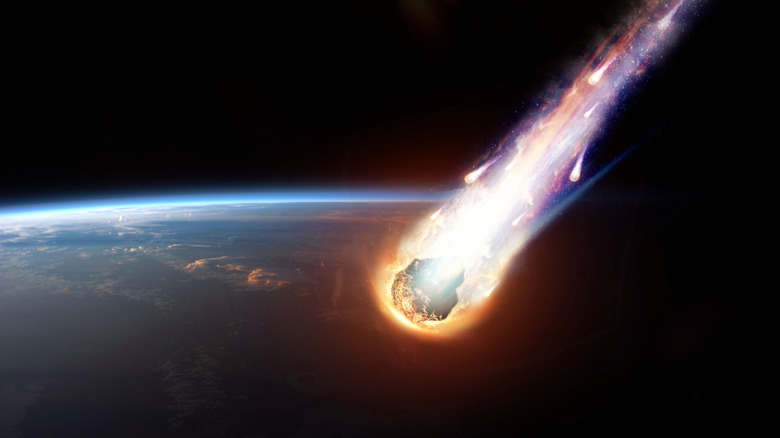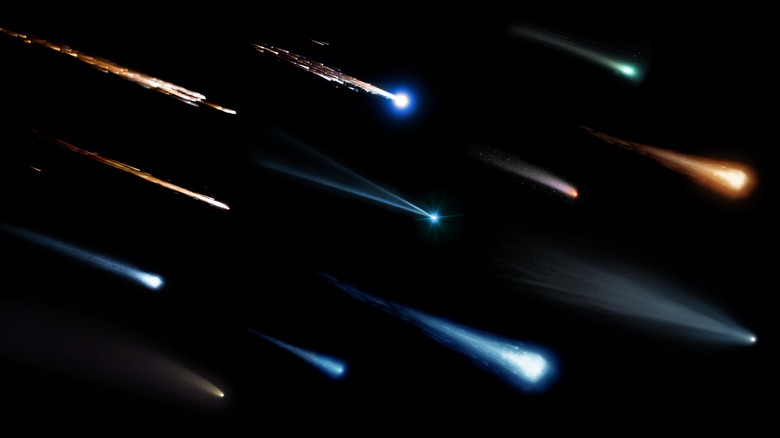The Asteroid Movie That Was The Most Scientifically Accurate
Hollywood has a fascination with the overlap between the exploration of outer space and the destructive force of our natural environment. There have been a great many iterations of the quintessential movie about what would happen if an asteroid was going to hit the Earth. Vissiniti has compiled a list of every Earth-threatening asteroid and comet movie made, with the first of all 104 movies being released in 1954 ("Crash of the Moons" and "Menace from Outer Space" both hit theaters during that year).
2021's "Don't Look Up" turns the trope of the asteroid movie on its head for a unique take on the threat of cosmic destruction through a lens of cynicism and political satire. But regardless of the cinematography, star-studded cast, or deeper premise running beyond the core antagonist of cosmic nature, most of these destruction films sacrifice the science for a compelling narrative that will get audiences talking.
However, not all asteroid movies make this trade-off entirely. In a BuzzFeed interview, Neil deGrasse Tyson suggests that "Deep Impact" "had really good science going there." "Deep Impact" follows a narrative roughly similar to other disaster movies: The team works to avert a looming extinction-level event in the form of a comet by deploying nuclear devices in an effort to knock it off its collision course with the Earth. Ultimately, the crew sacrifices itself to destroy part of the comet, saving humanity in the process.
Celestial bodies do threaten the Earth from time to time
One thing that asteroid and comic movies miss (or play up for dramatic effect) is the reality that the Earth is pelted by space junk on a consistent basis. Cosmos Magazine reports that about 6,100 meteors that are large enough to reach the ground strike the planet every year — resulting in roughly 17 collisions every day. Often, these go unnoticed because the majority of the Earth's surface is covered in water, and vast swaths of land remain uninhabited — even as humans continue to spread out across the planet. Indeed, the University of Texas estimates that around 57% of the Earth's land area remains uninhabited.
In truth, this is all simple science. Space is filled with debris of all sorts, and an even larger number of particles pass close enough to be burned up in Earth's atmosphere without ever being noticed by the layperson. Added to this reality, NASA reports that no known asteroid or comet that could cause significant harm to human life has been identified to be on a collision course with the planet, but they also admit if there was an Earth-killing asteroid, you wouldn't have time to tweet about it. Science Norway estimates that these types of life-threatening collisions might happen roughly once every 100 million years.
Deep Impact grounded itself in science
The entertainment value of "Deep Impact" was immense when the movie hit theaters. Box Office Mojo reports that the film grossed nearly $350 million worldwide, on an estimated budget of $75 million. Neil deGrasse Tyson's love for the movie seems to come from its grounding in the actual physics of gravity (via BuzzFeed). The way in which the crew must physically pull themselves onto and around the comet is entirely representative of the way that a low-gravity environment would play out.
Others in the scientific community agree with Tyson's assessment, claiming that it was the most technically accurate space disaster movie made up to that point (via Science). In a present-day example, scientists hold high praise for "The Expanse" for the same basic reasons (via Ars Technica), but these adulations for a film centered on space exploration or salvation have been few and far between in both the time of "Deep Impact" and in the years since.
Another important reason that scientists praise "Deep Impact" is the fact that the piece of a comet that eventually strikes the Earth lands in the Atlantic Ocean. In contrast, most movies of this genre opt for impact over dense urban cities — presumably to take advantage of the cinematic experience provided by a collision with the White House, Eifel Tower, or Christ the Redeemer. Of course, the resulting megatsunami in "Deep Impact" also offers plenty of opportunities for similarly themed shots.


